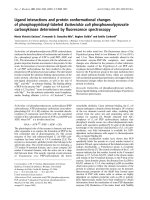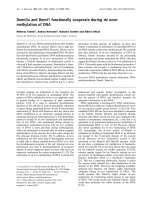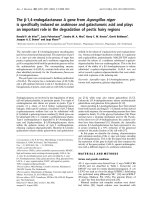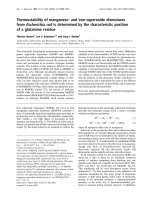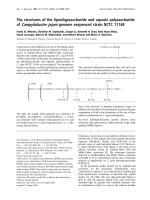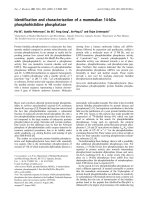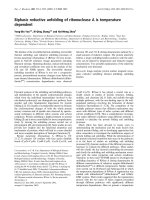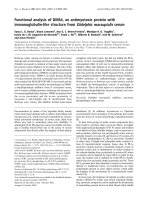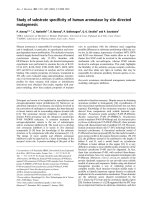Báo cáo y học: "Acquired angioedema" pdf
Bạn đang xem bản rút gọn của tài liệu. Xem và tải ngay bản đầy đủ của tài liệu tại đây (287.24 KB, 5 trang )
REVIEW Open Access
Acquired angioedema
Marco Cicardi
*
, Andrea Zanichelli
Abstract
Acquired angioedema (AAE) is characterized by acquired deficiency of C1 inhibitor (C1-INH), hyperactivation of the
classical pathway of human complement and angioedema symptoms mediated by bradykinin released by inap-
propriate activation of the contact-kinin system. Angioedema recurs at unpredictable intervals, lasts from two to
five days and presents with edema of the skin (face, limbs, genitals), severe abdominal pain with edema of the
gastrointestinal mucosa, life-threateing edema of the upper respiratory tract and edema of the oral mucosa and of
the tongue. AAE recurs in association with various conditions and particularly with different forms of lymphoproli-
ferative disorders. Neutralizing autoantibodies to C1-INH are present in the majority of patients. The therapeutic
approach to a patient with AAE should first be aimed to avoid fatalities due to angioedema and then to avoid the
disability caused be angioedema recurrences. Acute attacks can be treated with plasma-derived C1-INH, but some
patients become non-responsive and in these patients the kallikrein inhibitor ecallantide and the bradykinin recep-
tor antagonist icatibant can be effective. Angioedema prophylaxis is performed using antifibrinolytic agents and
attenuated androgens with antifibrinolytic agents providing somewhat better results. Treatment of the associated
disease can resolve AAE in some patients.
Review
The symptoms
The three key elements of the syndrome commonly
referred to as acquired angioedema (AAE), which was
first described by Caldwell in 1972 [1], are acquired
deficiency of C1 inhibitor (C1-INH), hyperactivation of
the classical pathway of human complement and recur-
rent angioedema symptoms. It is considered a very rare
condition wit h just more than 100 patients reported in
the literat ure [2]. In absence of epidemiological data, we
can only speculate about its prevalence. In our list of
angioedema patien ts, we found 1 AAE every 10 patients
with the hereditary form of C1-INH deficiency (heredi-
tary angioedema, HAE). HAE minimal prevalence in the
population is 1.41/100,000 and usual estimated preva-
lence between 1:10,000 and 1:50,0 00 [3,4]. Therefore , a
very crude estimated prevalence of AAE could range
between 1:100,000 and 1:500,000. W e believe that the
actual number is much higher than this because the
condition is frequently unrecognized.
From the clinical point of view the angioedema symp-
toms that characterize AAE can not be dif ferentiated
from those present in HAE patients who have a
deficiency of C1-INH due to mutations in one of the
two alleles coding for this protein [5]. This could be
anticipated based on the fact that in both forms angio-
edema is mediated by bradykinin episodically released
by inappropriate activation of the contact-kinin system
lacking its major physiol ogic regulator C1-INH [6,7].
Thus, similar to HAE patients, patients with AAE have
no major urticaria flare. Angioedema recurs at unpre-
dictable interval s, lasting from two to five days and pre-
senting with disfiguring, non pitting, non -pruritic ed ema
of the skin (face, limbs, genitals), severe abdominal pain
for edema of the gastrointestinal mucosa leading to tem-
porary bowel occlusion (Figure 1) [8], life-threateing
edema of the upper respiratory tract and edema of the
oral mucosa and of the to ngue [2]. The only significant
clinical difference between HAE and AAE is the age of
onset o f symptoms (Table 1): within the second decade
of life for mo re than 90% o f patients with HAE, after
the fourth decade for tho se with AAE. Some additio nal
minor differences can be found looking at different rates
of recurrences at specific sites. Angioedema of the gas-
trointestinal mucosa causing abdominal pain is reported
by nearly 80% of patients with HAE while less than 50%
of our AAE patients and around 30% of those from
Bouillet et al [9] reported such symptoms. Nevertheless,
presentation of AAE with abdominal symptoms has
* Correspondence:
Dipartimento di Scienze Cliniche “Luigi Sacco” Università di Milano, Milano
Italy, Ospedale L.Sacco Milano, Italy
Cicardi and Zanichelli Allergy, Asthma & Clinical Immunology 2010, 6:14
/>ALLERGY, ASTHMA & CLINICAL
IMMUNOLOGY
© 2010 Cicardi and Zanichelli; licensee BioMed Centra l Ltd. This is an Op en Access article distributed under the terms of the Creative
Commons Attribution License (http://creative commons.org/licenses/by/2.0), which permits unrestricted use, di stribution, and
reproduction in any medium, provided the original work is properly cited.
been reported in our series and in the literature [10].
Cutaneous angioedema in HAE patients is typically loca-
lized to the extremities. Even if this location is also pre-
sent in patients with AAE, in them angioedema recurs
more frequently in the face than in the limbs [9] and we
also noticed a rather frequent involvement of tongue
and uvula; (Figure 2).
The pathogenesis of the acquired defect of C1 inhibitor
and the associated disease
In the first patients reported by Caldwell [1], AAE
occurred in presence of lymphoma. This association has
been repeatedly confirmed in subsequent patients
[11-13] and even if lymphoma is not the only disease
associated with AAE, it remains the preeminent disease
association. Along with lymphoma, other benign forms
of lymphoproliferation, namely monoclonal gammopathy
of uncertain significance (MGUS), have been reported
with high frequency in assoc iation with AAE. Capacity
of lymphoma cells to deplete C1-INH or to cause its
consumption through C1 activation, and the possibility
to treat AAE by curing the underlying lymphoma, linked
the lymphoproliferative disease to the pa thogenesis of
AAE [1,11-15]. In 1985, neutralizing autoantibodies to
C1-INH were described in a few otherwise healthy
patients [16,17]. Anti-C1-INH autoantibodies recognize
epitopes around the reactive c enter of C1-INH and by
binding these epitopes render the protein functionally
inactive and/or increase its catabolism [18,19]. Autoanti-
body-mediated AAE seemed to be, at the beginning, a
new type of AAE in which autoreactive immunoglobu-
lins, instead of lymphoma tissues, was the cause of C1-
INH depletion [20]. Re-evaluation of existing and new
AAE patients demonstrated that autoantibodies could
Figure 1 Capsule endoscopy showing bowel occlusion due to angioedema of the gastr ointest inal mucosa in a patient with C1-INH
deficiency suffering from acute abdominal pain.
Table 1 Differences between acquired and hereditary angioedema due to C1-INH deficiency
Onset < 20 y.o. Onset >40 y.o. Abdominal C1q < 50%
% pts. % pts. % pts. %pts
Acquired angioedema 0 94 48 70
Hereditary angioedema 12 3 87 < 5
Data are based on a personal case list of 43 patients with a cquired and 448 with hereditary angioedema.
Cicardi and Zanichelli Allergy, Asthma & Clinical Immunology 2010, 6:14
/>Page 2 of 5
be present along with lymphoma and that the M com-
ponent detected in several AAE patients corresponded
to the anti-C1-INH autoantibodies [21]. Based on these
findings, we can now see AAE as a condition with dif-
ferent form of abnormal B cell proliferation progressing
from autoreactivity to malignant lymphoma. Whether
the different degrees of lymphoproliferation found in
AAE patients are evolutionary stages of the same pro-
cess starting from expansion of anti-C1-INH autoreac-
tive clone(s) has not yet been clarified [22].
Although lymphoproliferative diseases represent the
main group encountered in AAE and a direct pathoge-
netic relationship between the two conditions can not
be questioned, SLE, different neoplasias and infections
have also been described in association w ith AAE
[23-33]. The possibility chance association for some of
these conditions can not be completely ruled out.
The diagnosis
AAE is first suspected in patients aged 40 or above who
present with recurrent cutaneous and/or mucosal
angioedema without urticaria, without an evident trig-
gering factor, and without family history of angioedema.
Measurement of C1-INH and C4 antigen in such
patients is the first step. If both are normal, the defi-
ciency of C1-INH is very unlike. I f both are low (with
C1-INH below 50% of normal on two separ ate determi-
nat ions) diagnosis of C1-I NH deficiency is made. If just
C4 is reduced, C1-INH functional activity needs to be
determined and if low (below 50% of normal on two
separate determinations) diagnosis of C1-INH defi ciency
is made. Once this diagnosis has been made, additional
testing is necessary to distinguish between inherited and
acquired deficiency. This testing includes deter mination
of C1q which is reduced in 70% of patients with AAE
and is normal in HAE. If C1q is reduced, diagnosis of
AAE can be established. If C1q is normal, autoantibo-
dies to C1-INH can be investigated and their presence
at high titre allows diagnosing AAE. If antibodies are
negative, the diagnosis of AAE is assumed when com-
plete screening of C1-INH gene gives no evidence of
mutations affecting C1-INH protein. Major limits to this
procedurearetheinadequateavailabilityandstandardi-
zation of C1-INH functional measurements [34] and the
possibility to look for anti-C1-INH autoantibodies only
in a few specialized research laboratories. Therefore,
careful harmonization of clinical and laboratory findings
is mandatory to establish the diagnosis of AAE.
Patient s with this diagnosis should undergo basic test-
ing for lymphoproliferative and autoimmune disease. In
addition to complete physical exam, we suggest that all
patients have laboratory tes ting for complete blood cell
count with differential, serum protein electrophoresis,
antinuclear antibodies, chest X ray and abdominal ultra-
sound assessing lymphoid tissue. Due to the limited
recurrences of other associated diseases, we do not see
the need to systematically screen for other neoplasia or
infection without specific clinical indications.
The treatment
The therapeutic approach to a patien t with AAE should
fir st be aimed to avoid fatalities due to angioedema and
then to avoid the disability caused be angioedema recur-
rences. Angioedema- related fatalities derive from laryn-
geal edema. Based on the efficacy of replacement
therapy with plasma-derived C1-INH in revert ing laryn-
geal edema i n patients with HAE [35], the same
approac h has been used for AAE. This treatment works
in the majority but not in all AAE patients and in o ur
experience some patient with AAE become progressively
non responsive to plasma-derived C1-INH or need
increased doses [5]. No other treatment for angioedema
attacks has been extensively used in patients with AAE
and therefore there is no established therapeutic alterna-
tive to plasma- derived C1-INH for life-threatening
attack s. Non-responsive patien ts have just been assis ted
with invasive procedures aimed to maintain patency of
upper airways during emergency. In recent years in a
few AAE patients we have used two of the new treat-
ments that have been proposed for HAE acute attacks:
the kallikrein inhibitor ecallantide and the bradykinin B2
antagonist icatibant [36]. Since refractoriness to plasma-
derived C1-INH is due to its aut oantibody-mediated
rapid catabolism, the use of drugs different from C1-
INH but active in reversing HAE attacks have very good
rationale for being effective in AAE. In fact from our
Figure 2 Edema of the tongue in a patient with acquired
angioedema.
Cicardi and Zanichelli Allergy, Asthma & Clinical Immunology 2010, 6:14
/>Page 3 of 5
limited experience response is extremely favourable. We
treated 2 facial attacks in t wo patients with ecallantide
and 1 laryngeal and 3 facial attacks in another patient
with icatibant. Two of these patients were completely,
and one partially, non-responsive to plasma derived C1-
INH. All treated attacks responded very rapidly either to
ecallantide or icatibant. The critical condition of C1-
INH non-responder patients and the absence of licensed
drugs strongly indicate the need for off-label treatments.
Therefore, we recommend all our AAE patients always
have 3000 U of plasma-derived C 1-INH immediately
available and treat attacks with 1500 U and repeating if
ineffective. In the event of laryngeal edema, resuscitation
facilities should be available. For those patients who
have slow or no response, ecallantide or icatibant should
be provided.
Reducing disability related to angioedema recur-
rences can be obtained by shortening attacks with an
on-demand treatment with plasma-derived C1-INH, by
preventing attacks with long term prevention with
antifibrinolytics or androgens, o r by curing the asso-
ciated disease. The latter is the first choice when the
associated disease has per se an indication to be trea-
ted. Resolution of the associated disease results in vari-
able degrees of resolution of AAE from symptomatic
improvement to complete biochemical and clinical
recovery [13-15]. Treatment of the associated disease
aimed only to control angioedema symptoms requires
careful risk/benefit evaluation. Since most of the time
the associated disease is lymphoproliferative, the choice
to start a patient on chemotherapy or immunosuppres-
sant is not always straightforward. Long-term treat-
ment to prevent angioedema symptoms is often used
in HAE and has also been used in AAE. While in HAE
androgen derivatives are very effective prophylactic
agents, results may not be as good in AAE. The reason
for this is not totally clear. We know that attenuated
androgens can increase the plasma levels of C1-INH
[37]. Even if effective androgen doses in HAE do not
require a measurable increase of C1-INH in plasma, it
is still possible that these drugs relay on C1-INH pro-
duction and their efficacy is less when C1-INH catabo-
lism is very rapid [38]. In contrast, antifibrinolytic
agents, the other class of drugs used for symptom pro-
phylaxis in HAE [39,40], se em to have better e fficacy
in AAE than in HAE. It is assumed that the effect of
these drugs in C1-INH deficient patients works
through their anti-plasmin activity. Plasmin is critical
for angioedema symptoms in C1-INH deficiency
although the role is not clearly defined [41]. In AAE
patients, the instability of the sys tems controlled by
C1-INH is higher than in HAE and active plasmin is
also generated separate from angioedema symptoms
reinforcing the rationale for efficacy of antifibrinolytics
in this condition [42-45]. At present, we consider anti-
fibrinolytic agents as the first choice drug fo r angioe-
dema prophylaxis in AAE. Prevention of attacks with
continuous infusions of plasma-derived C1-INH has
been attempted with controversial results and in our
opinion having very little rationale [46,47]. The half
life of plasma- derived C1-INH in HAE indicates two
infusions per week as the minimum to maintain pro-
tective prophylactic plasma levels [48]. Even if one
assumes that AAE patients will not require a more
intensive program because of the faster C1-INH cata-
bolism and will not increase the risk of becoming
resistant to p lasma-derived C1-INH, this prophylactic
infusion regimen seems justified only for those patients
with two or more severe attacks per week, a condition
that we did not find in any of our 42 AAE patients.
We reserve plasma-derived C1-INH infusions for on-
demand treatment of severe angioedema events and do
not use this for prophylaxis.
Acknowledgements
Supported by Telethon grant n. GGP08223 and a grant from Invernizzi
Foundation
Authors’ contributions
MC wrote the review and AZ gave critical revision and collected the
personal data that are reported. Both authors have read and approved the
final manuscript.
Competing interests
MC has consultancy agreement with Dyax, Pharming and Shire, is in
advisory board and invited speaker of Dyax, Shire. CSL Behring. AZ has been
Invited speaker for CSL Behring and Shire
Received: 26 April 2010 Accepted: 28 July 2010 Published: 28 July 2010
References
1. Caldwell JR, Ruddy S, Schur PH, Austen KF: Acquired C1 inhibitor
deficiency in lymphosarcoma. Clin Immunol Immunopathol 1972, 1:39-52.
2. Zingale LC, Castelli R, Zanichelli A, Cicardi M: Acquired deficiency of the
inhibitor of the first complement component: presentation, diagnosis,
course, and conventional management. Immunol Allergy Clin North Am
2006, 26:669-90.
3. Bygum A: Hereditary angio-oedema in Denmark: a nationwide survey. Br
J Dermatol 2009, 161:1153-8.
4. Zuraw BL: Clinical practice. Hereditary angioedema. N Engl J Med 2008,
359:1027-36.
5. Agostoni A, Aygören-Pürsün E, Binkley KE, Blanch A, Bork K, Bouillet L,
Bucher C, Castaldo AJ, Cicardi M, Davis AE, De Carolis C, Drouet C,
Duponchel C, Farkas H, Fáy K, Fekete B, Fischer B, Fontana L, Füst G,
Giacomelli R, Gröner A, Hack CE, Harmat G, Jakenfelds J, Juers M, Kalmár L,
Kaposi PN, Karádi I, Kitzinger A, Kollár T, et al: Hereditary and acquired
angioedema: problems and progress: proceedings of the third C1
esterase inhibitor deficiency workshop and beyond. J Allergy Clin
Immunol 2004, 114:S51-131.
6. Nussberger J, Cugno M, Amstutz C, Cicardi M, Pellacani A, Agostoni A:
Plasma bradykinin in angio-oedema. Lancet 1998, 351:1693-7.
7. Davis AE: C1 inhibitor and hereditary angioneurotic edema. Annu Rev
Immunol 1988, 6:595-628.
8. Zingale LC, Zanichelli A, Deliliers DL, Rondonotti E, De Franchis R, Cicardi M:
Successful resolution of bowel obstruction in a patient with hereditary
angioedema. Eur J Gastroenterol Hepatol 2008, 20:583-7.
Cicardi and Zanichelli Allergy, Asthma & Clinical Immunology 2010, 6:14
/>Page 4 of 5
9. Bouillet-Claveyrolas L, Ponard D, Drouet C, Massot C: Clinical and biological
distinctions between type I and type II acquired angioedema. Am J Med
2003, 115:420-1.
10. Eck SL, Morse JH, Janssen DA, Emerson SG, Markovitz DM: Angioedema
presenting as chronic gastrointestinal symptoms. Am J Gastroenterol
1993, 88:436-9.
11. Schreiber AD, Zweiman B, Atkins P, Goldwein F, Pietra G, Atkinson B,
Abdou NI: Acquired angioedema with lymphoproliferative disorder:
association of C1 inhibitor deficiency with cellular abnormality. Blood
1976, 48:567-80.
12. Hauptmann G, Lang JM, North ML, Oberling F, Mayer G, Lachmann P:
Acquired c1-inhibitor deficiencies in lymphoproliferative diseases with
serum immunoglobulin abnormalities. A study of three cases. Blut 1976,
32:195-206.
13. Castelli R, Deliliers DL, Zingale LC, Pogliani EM, Cicardi M:
Lymphoproliferative disease and acquired C1 inhibitor deficiency.
Haematologica 2007, 92:716-8.
14. Hauptmann G, Petitjean F, Lang JM, Oberling F: Acquired C1 inhibitor
deficiency in a case of lymphosarcoma of the spleen. Reversal of
complement abnormalities after splenectomy. Clin Exp Immunol 1979,
37:523-31.
15. Levi M, Hack CE, van Oers MH: Rituximab-induced elimination of acquired
angioedema due to C1-inhibitor deficiency. Am J Med 2006, 119:e3-5.
16. Jackson J, Sim RB, Whelan A, Feighery C: An IgG autoantibody which
inactivates C1-inhibitor. Nature 1986, 323:722-4.
17. Alsenz J, Bork K, Loos M: Autoantibody-mediated acquired deficiency of
C1 inhibitor. N Engl J Med 1987, 316:1360-6.
18. Malbran A, Hammer CH, Frank MM, Fries LF: Acquired angioedema:
observations on the mechanism of action of autoantibodies directed
against C1 esterase inhibitor. J Allergy Clin Immunol 1988, 81:1199-204.
19. Mandle R, Baron C, Roux E, Sundel R, Gelfand J, Aulak K, Davis AE, Rosen FS,
Bing DH: Acquired C1 inhibitor deficiency as a result of an autoantibody
to the reactive center region of C1 inhibitor. J Immunol 1994, 152:4680-5.
20. Alsenz J, Loos M: The acquired C1-INH deficiencies with autoantibodies
(AAE type II). Behring Inst Mitt 1989, , 84: 165-72.
21. Cicardi M, Beretta A, Colombo M, Gioffre D, Cugno M, Agostoni A:
Relevance of lymphoproliferative disorders and of anti-C1 inhibitor
autoantibodies in acquired angio-oedema. Clin Exp Immunol 1996,
106:475-80.
22. Cugno M, Castelli R, Cicardi M: Angioedema due to acquired C1-inhibitor
deficiency: a bridging condition between autoimmunity and
lymphoproliferation. Autoimmun Rev 2008, 8:156-9.
23. Nettis E, Colanardi MC, Loria MP, Vacca A: Acquired C1-inhibitor deficiency
in a patient with systemic lupus erythematosus: a case report and
review of the literature. Eur J Clin Invest 2005, 35:781-4.
24. Nagy L, Hannema A, Swaak A: Acquired C1 inhibitor deficiency associated
with systemic lupus erythematosus, secondary antiphospholipid
syndrome and IgM monoclonal paraproteinaemia. Clin Rheumatol 1999,
18:56-8.
25. Ochonisky S, Intrator L, Wechsler J, Revuz J, Bagot M: Acquired C1 inhibitor
deficiency revealing systemic lupus erythematosus. Dermatology 1993,
186:261-3.
26. Nakamura S, Yoshinari M, Saku Y, Hirakawa K, Miishima C, Murai K,
Tokiyama K, Fujishima M: Acquired C1 inhibitor deficiency associated with
systemic lupus erythematosus affecting the central nervous system. Ann
Rheum Dis 1991, 50:713-6.
27. Wasserfallen JB, Spaeth P, Guillou L, Pecoud AR: Acquired deficiency in C1-
inhibitor associated with signet ring cell gastric adenocarcinoma: a
probable connection of antitumor-associated antibodies, hemolytic
anemia, and complement turnover. J Allergy Clin Immunol 1995, 95:124-31.
28. Cohen SH, Koethe SM, Kozin F, Rodey G, Arkins JA, Fink JN: Acquired
angioedema associated with rectal carcinoma and its response to
danazol therapy. Acquired angioedema treated with danazol. J Allergy
Clin Immunol 1978, 62:217-21.
29. Varvarovska J, Sykora J, Stozicky F, Chytra I: Acquired angioedema and
Helicobacter pylori infection in a child. Eur J Pediatr 2003, 162:707-9.
30. Reche M, Caballero T, López-Trascasa M, Arribas JR, López Serrano MC:
Angioedema and transient acquired C1 inhibitor functional deficiency in
HIV infection: case report. Aids 2002, 16:1561.
31. Farkas H, Gyeney L, Majthenyi P, Fust G, Varga L: Angioedema due to
acquired C1-esterase inhibitor deficiency in a patient with Helicobacter
pylori infection. Z Gastroenterol 1999, 37:513-8.
32. Minh D, Czink E, Fust G, Hollan SR: Acquired C1-esterase inhibitor
deficiency and recurrent herpes infection in a patient with chronic
lymphocytic leukemia. Diagn Immunol 1983, 1:68-71.
33. Cicardi M, Frangi D, Bergamaschini L, Gardinali M, Sacchi G, Agostoni A:
Acquired C1 inhibitor deficiency with angioedema symptoms in a
patient infected with Echinococcus granulosus. Complement 1985,
2:133-9.
34. Wagenaar-Bos IG, Drouet C, Aygören-Pursun E, Bork K, Bucher C, Bygum A,
Farkas H, Fust G, Gregorek H, Hack CE, Hickey A, Joller-Jemelka HI,
Kapusta M, Kreuz W, Longhurst H, Lopez-Trascasa M, Madalinski K,
Naskalski J, Nieuwenhuys E, Ponard D, Truedsson L, Varga L, Nielsen EW,
Wagner E, Zingale L, Cicardi M, van Ham SM: Functional C1-inhibitor
diagnostics in hereditary angioedema: assay evaluation and
recommendations. J Immunol Methods 2008, 338:14-20.
35. Bork K, Barnstedt SE: Treatment of 193 episodes of laryngeal edema with
C1 inhibitor concentrate in patients with hereditary angioedema. Arch
Intern Med 2001, 161:714-8.
36. Frank MM, Jiang H: New therapies for hereditary angioedema: disease
outlook changes dramatically. J Allergy Clin Immunol 2008, 121:272-80.
37. Gelfand JA, Sherins RJ, Alling DW, Frank MM: Treatment of hereditary
angioedema with danazol. Reversal of clinical and biochemical
abnormalities. N Engl J Med 1976, 295:1444-8.
38. Melamed J, Alper CA, Cicardi M, Rosen FS: The metabolism of C1 inhibitor
and C1q in patients with acquired C1- inhibitor deficiency. J Allergy Clin
Immunol 1986, 77:322-6.
39. Frank MM, Sergent JS, Kane MA, Alling DW: Epsilon aminocaproic acid
therapy of hereditary angioneurotic edema. A double-blind study. N Engl
JMed1972, 286:808-12.
40. Sheffer AL, Austen KF, Rosen FS: Tranexamic acid therapy in hereditary
angioneurotic edema. N Engl J Med 1972, 287:452-4.
41. Donaldson VH, Rosen FS, Bing DH: Role of the second component of
complement (C2) and plasmin in kinin release in hereditary
angioneurotic edema (H.A.N.E.) plasma. Trans Assoc Am Physicians 1977,
90:174-83.
42. Cugno M, Hack CE, de Boer JP, Eerenberg AJ, Agostoni A, Cicardi M:
Generation of plasmin during acute attacks of hereditary angioedema. J
Lab Clin Med 1993, 121:38-43.
43. Cugno M, Cicardi M, Agostoni A: Activation of the contact system and
fibrinolysis in autoimmune acquired angioedema: a rationale for
prophylactic use of tranexamic acid. J Allergy Clin Immunol 1994, 93:870-6.
44. Cugno M, Cicardi M, Coppola R, Agostoni A: Activation of factor XII and
cleavage of high molecular weight kininogen during acute attacks in
hereditary and acquired C1-inhibitor deficiencies. Immunopharmacology
1996, 33:361-4.
45. Cugno M, Cicardi M, Bottasso B, Coppola R, Paonessa R, Mannucci PM,
Agostoni A: Activation of the coagulation cascade in C1-inhibitor
deficiencies. Blood 1997, 89:3213-8.
46. Levi M, Choi G, Picavet C, Hack C: Self-administration of C1-inhibitor
concentrate in patients with hereditary or acquired angioedema caused
by C1-inhibitor deficiency. J Allergy Clin Immunol 2006, 117:904-8.
47. Bork K, Witzke G: Long-term prophylaxis with C1-inhibitor (C1 INH)
concentrate in patients with recurrent angioedema caused by hereditary
and acquired C1-inhibitor deficiency. J Allergy Clin Immunol 1989,
83:677-82.
48. Martinez-Saguer I, Rusicke E, Aygören-Pürsün E, von Hentig N, Klingebiel T,
Kreuz W: Pharmacokinetic analysis of human plasma-derived pasteurized
C1-inhibitor concentrate in adults and children with hereditary
angioedema: a prospective study. Transfusion 2010, 50:354-60.
doi:10.1186/1710-1492-6-14
Cite this article as: Cicardi and Zanichelli: Acquired angioedema. Allergy,
Asthma & Clinical Immunology 2010 6:14.
Cicardi and Zanichelli Allergy, Asthma & Clinical Immunology 2010, 6:14
/>Page 5 of 5
